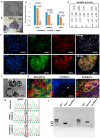Generation of iPSCs from a Patient with the M694V Mutation in the MEFV Gene Associated with Familial Mediterranean Fever and Their Differentiation into Macrophages
- PMID: 38892289
- PMCID: PMC11173119
- DOI: 10.3390/ijms25116102
Generation of iPSCs from a Patient with the M694V Mutation in the MEFV Gene Associated with Familial Mediterranean Fever and Their Differentiation into Macrophages
Abstract
Familial Mediterranean fever (FMF) is a systemic autoinflammatory disorder caused by inherited mutations in the MEFV (Mediterranean FeVer) gene, located on chromosome 16 (16p13.3) and encoding the pyrin protein. Despite the existing data on MEFV mutations, the exact mechanism of their effect on the development of the pathological processes leading to the spontaneous and recurrent autoinflammatory attacks observed in FMF, remains unclear. Induced pluripotent stem cells (iPSCs) are considered an important tool to study the molecular genetic mechanisms of various diseases due to their ability to differentiate into any cell type, including macrophages, which contribute to the development of FMF. In this study, we developed iPSCs from an Armenian patient with FMF carrying the M694V, p.(Met694Val) (c.2080A>G, rs61752717) pathogenic mutation in exon 10 of the MEFV gene. As a result of direct differentiation, macrophages expressing CD14 and CD45 surface markers were obtained. We found that the morphology of macrophages derived from iPSCs of a patient with the MEFV mutation significantly differed from that of macrophages derived from iPSCs of a healthy donor carrying the wild-type MEFV gene.
Keywords: Familial Mediterranean fever; MEFV gene; differentiation; macrophages; patient-specific induced pluripotent stem cells.
Conflict of interest statement
The authors declare no conflicts of interest.
Figures


Similar articles
-
R202Q/M694V as novel MEFV gene mutations in chronic periodontitis and familial Mediterranean fever.J Periodontal Res. 2017 Dec;52(6):994-1003. doi: 10.1111/jre.12467. Epub 2017 Jun 7. J Periodontal Res. 2017. PMID: 28590056
-
Familial Mediterranean fever (FMF) phenotype in patients homozygous to the MEFV M694V mutation.Eur J Med Genet. 2019 Jun;62(6):103532. doi: 10.1016/j.ejmg.2018.08.013. Epub 2018 Aug 29. Eur J Med Genet. 2019. PMID: 30171907
-
The spectrum of Familial Mediterranean Fever gene (MEFV) mutations and genotypes in Iran, and report of a novel missense variant (R204H).Eur J Med Genet. 2017 Dec;60(12):701-705. doi: 10.1016/j.ejmg.2017.09.007. Epub 2017 Sep 21. Eur J Med Genet. 2017. PMID: 28943464
-
The significance of carrying MEFV variants in symptomatic and asymptomatic individuals.Clin Genet. 2024 Sep;106(3):217-223. doi: 10.1111/cge.14566. Epub 2024 May 31. Clin Genet. 2024. PMID: 38818540 Review.
-
New Diseases Linked to MEFV Variants or Pyrinopathies.J Allergy Clin Immunol Pract. 2025 Mar;13(3):522-532. doi: 10.1016/j.jaip.2024.12.022. Epub 2024 Dec 24. J Allergy Clin Immunol Pract. 2025. PMID: 39725312 Review.
Cited by
-
Targeting pyroptosis in myocardial inflammation and fibrosis: molecular mechanisms and therapeutic strategies.Apoptosis. 2025 Jul 23. doi: 10.1007/s10495-025-02151-8. Online ahead of print. Apoptosis. 2025. PMID: 40702245 Review.
References
MeSH terms
Substances
LinkOut - more resources
Full Text Sources
Research Materials
Miscellaneous

